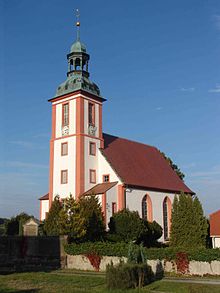Spitzkunnersdorf
|
Spitzkunnersdorf
Leutersdorf municipality
Coordinates: 50 ° 56 ′ 15 ″ N , 14 ° 41 ′ 5 ″ E
|
||
|---|---|---|
| Height : | 340 (320-400) m | |
| Area : | 9.35 km² | |
| Residents : | 1820 (Dec. 31, 1997) | |
| Population density : | 195 inhabitants / km² | |
| Incorporation : | January 1, 1998 | |
| Postal code : | 02794 | |
| Primaries : | 035842, 03586 | |
|
Location of Spitzkunnersdorf in Saxony |
||
Spitzkunnersdorf is a district of the Saxon community Leutersdorf in the district of Görlitz . The Waldhufendorf was first mentioned in the middle of the 14th century, the earliest mention of the church dates back to the same century.
geography
The place is in the south of Upper Lusatia near the German-Czech border. Surrounding places are Seifhennersdorf in the west, Leutersdorf in the northwest, Oderwitz in the northeast, Mittelherwigsdorf in the southeast, Hainewalde and Großschönau in the south and beyond the border Varnsdorf in the southwest.
There are border crossings to Varnsdorf in Seifhennersdorf and Großschönau. The federal road 96 (section Bautzen-Zittau) runs through the neighboring town of Oderwitz .
history
Spitzkunnersdorf was first mentioned in 1347 as a church village under the name Cunarstorf . A Nikolaikirche was first mentioned in 1372, a new building was built around 1501. The main income of the inhabitants was agriculture and cattle breeding. Only after the Thirty Years' War did Spitzkunnersdorf have a significant number of craftsmen.
In the years 1712 to 1716 the Evangelical-Lutheran Nikolaikirche was built on the site of the old church at the instigation of the feudal lord Otto Ludwig von Kanitz , which is now a sister church of the Kreuzkirche Seifhennersdorf . Inside are older epitaphs . Kanitz did not live to see the completion of the church tower in 1725; he died a year earlier.
Around 1800 the robber chief Johannes Karasek stayed in Spitzkunnersdorf.
Between 1790 and 1805 the districts of Wiesenthal and Neudorf were created on an elongated forest hoof of the demolished Wiesenthal suburb .
In the 19th century, Spitzkunnersdorf developed into an industrial community, and the majority of its residents found work in weaving mills . Towards the end of the century the interior of the church was extensively renovated.
As early as 1834 the first Wiesenthal school (timber construction, surrounding framework) was built. In 1909 the construction of the second Wiesenthal school (stone building) began, which was completed in 1910. In the same year the community received electricity for the first time.
On January 1, 1998, Spitzkunnersdorf was incorporated into Leutersdorf.
Population development
| year | Residents |
|---|---|
| 1834 | 1,984 |
| 1871 | 2456 |
| 1890 | 2298 |
| 1910 | 2104 |
| 1925 | 2060 |
| 1939 | 2167 |
| 1946 | 2327 |
| 1950 | 2563 |
| 1964 | 2346 |
| 1990 | 1915 |
| 1997 | 1820 |
In 1551, 20 possessed men and 19 gardeners were farming in Spitzkunnersdorf . The population increased to 1777 to 21 besessne man, 24 gardeners and 91 cottagers . Three economies were desolate that year.
The first population surveys, in which no longer the farms, but each individual resident was counted with the same value, took place in the Kingdom of Saxony in 1834. In that year, Spitzkunnersdorf had 1,984 inhabitants. Almost 60 years later the population had risen by a quarter to 2,456 in the year the German Empire was founded .
In the almost 50 years until 1925, the population fell to 2,060. A faith survey in that year showed that 1,909 residents (92.7%) were of Protestant faith.
From 1925 to 1939 the population increased again by around 100 to 2,167. After the end of the Second World War , 2,327 inhabitants were recorded in 1946. A brief increase, by which 2,563 inhabitants were recorded in 1950, was followed by a further decrease, so that in 1964 there were still 2,346 inhabitants. The effective population growth since 1946 was thus less than one percent.
The general population decline in many communities in the GDR was also felt in Spitzkunnersdorf. In the turning point of 1990, only 1,915 inhabitants were determined, i.e. fewer than in 1834. In the seven years up to the incorporation, the population fell again by almost 100 to 1,820.
Memorials
A memorial stone at the school in Hauptstrasse commemorates an unknown concentration camp inmate on a death march from a subcamp of the Groß-Rosen concentration camp , who was murdered by SS men in April 1945 . The urn with his ashes was buried in the Berlin memorial “Unter den Linden”.
Personalities
The Niederoderwitz folk painter Max Langer (1897–1985) was born in Spitzkunnersdorf.
Regular events
- Witches' fire at the fire station of the Spitzkunnersdorf volunteer fire brigade , annually on Walpurgis Night
- Pentecost singing, Whit Monday at Hofeberg
- Club summer festival, annually on the first weekend in July on the sports field
literature
- Cornelius Gurlitt : Spitzkunnersdorf. In: Descriptive representation of the older architectural and art monuments of the Kingdom of Saxony. 29. Issue: Amtshauptmannschaft Zittau (Land) . CC Meinhold, Dresden 1906, p. 234.
Individual evidence
- ↑ History of the Nikolaikirche. Retrieved March 17, 2010 .
- ^ The story of Spitzkunnersdorf. Retrieved August 2, 2008 .
- ^ StBA: Changes in the municipalities, see 1998
- ^ Spitzkunnersdorf in the Digital Historical Directory of Saxony
- ↑ Saxony regional register. Retrieved August 2, 2008 .


